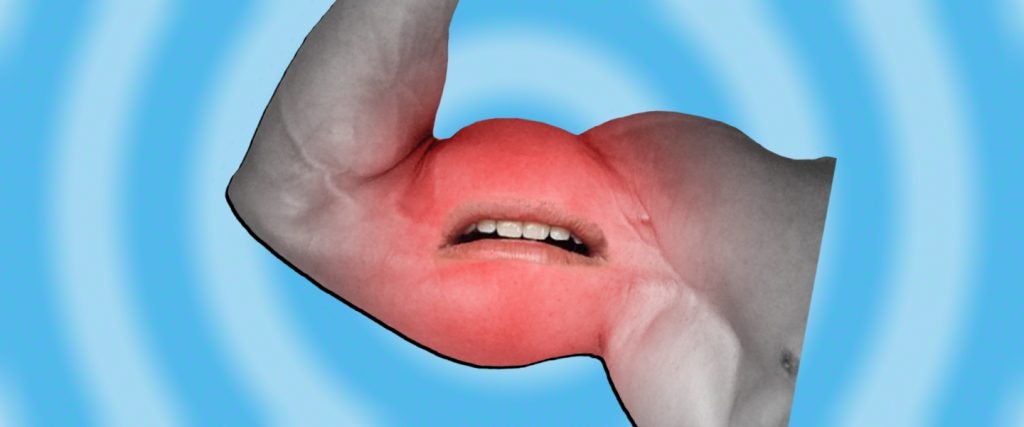One Sunday afternoon, I was relaxing at the front desk of Bally Total Fitness when my friend Leila skipped over with a special request. “Danielle just called and canceled our training session,” she informed me. “I really need a workout. Do you have time to help me train today?”
“Sure!” I answered. “Just show me what Danielle would normally have you do, and I’ll help you with your form and give you advice while you lift.”
With that, we strolled off to the club’s Hammer Strength room. I watched as Leila collected two 10-pound plates and two 5-pound plates, and placed one of each plate on the two rods protruding from the handles of the incline chest press machine. Then she sat down, smiled cheerfully and began casually pressing away at the weight while manifesting none of the telltale signs of exertion.
“Hold on a second,” I stopped her.
I turned to grab two more 10-pound plates from the storage rack, placed one on each side of the machine, and gestured for Leila to start lifting again. Her face grimaced and contorted as she pressed the weight, and she let out an audible groan. “Are you sure I should be lifting this?” she questioned.
The thing is, she completed 10 repetitions of 50 pounds with still far too much ease for my liking. This pattern repeated itself throughout the entirety of the workout. And yet, a couple weeks later, she pulled me aside and admitted, “Our workout wasn’t as much fun as usual — and I didn’t get to talk about all of the things that I like to talk about — but I definitely felt sore for the next few days!”
“Well, you don’t necessarily want to chase muscle soreness,” I responded. “But never feeling it at all is probably a sign that you haven’t been challenging yourself enough.”
I’m nearly 20 years removed from that conversation, but I stand by what I said: Muscle soreness is often a sign that an untrained or undertrained muscle has finally been put to the test. And if you’re ever going to experience the full benefits of a well-trained physique, you’re probably going to need to suffer through at least a few days and nights of noticeable muscle soreness over the course of your life.
But how do you define muscle soreness?
Muscle soreness is neither defined nor caused by just one thing. In fact, the presence of delayed onset muscle soreness (DOMS) is typically explained by the simultaneous presence of at least two of five possible causes: muscle spasms; connective tissue damage; muscle damage; inflammation; and enzyme efflux. Lactic acid also used to be included on this list until researchers proved this not to be the case.
Inflammation is the most common culprit, and it occurs following the normal post-training muscle-repair process. When muscle fibers undergo micro tearing during resistance training, the affected area is flooded by blood that’s intent on replenishing oxygen and clearing away waste from the trained regions of your body.
Muscle spasms are also known as muscle cramps, and they occur when your muscles forcibly contract and are unable to relax. They have several causes, but for our purposes, the most likely reasons will be muscle fatigue, muscle tightness and general overutilization of the muscles.
Connective tissue damage is usually the result of autoimmune disorders, with rheumatoid arthritis at the top of the list. Such diseases are known to cause pain, swelling, stiffness and the loss of functionality in joints.
Diagnosable muscle damage goes a step beyond the ordinary micro tearing of muscle fibers during intense resistance training. It typically takes the form of a muscle strain, which transpires when muscle fibers or tendons are either partially or completely torn during the course of training.
Last but not least is the enzyme efflux theory, an unproven assumption about how the body reacts to intense training. It’s theorized that calcium may accumulate in damaged muscles when they’ve experienced the sort of microtrauma exemplified by intense resistance training. When this happens, the accumulation of calcium may set off a series of reactions that results in the degeneration of muscle protein, which, in turn, causes further inflammation.
Wow! So all of that might be going on inside of me?
Well, if you’re experiencing soreness, chances are it’s the result of some combination of inflammation and muscle spasms. If you’ve taken a giant leap in the intensity level of your training, if you’ve spent an uncharacteristic amount of time away from the gym or you just happen to have stretched your muscles’ limits in an unprecedented fashion, that’s a textbook formula for inducing inflammation, along with the sort of muscle fatigue that often precedes muscle cramping.
For any of the other culprits, there are likely to be some other signs that are far more serious in nature, and you may end up on the receiving end of medical attention to address that degree of soreness.
Fortunately, the more routine your training sessions are, the fitter you will grow, and the less frequent your struggles with muscle soreness will be. Essentially, muscle soreness is a rite of passage on the road to fitness, and it’s in the same vein as what people say about traveling through hell, inasmuch as if you find yourself walking through hell, you should keep walking. You might not feel heavenly when you get to the other side, but you’re not gonna be in agony anymore either.

